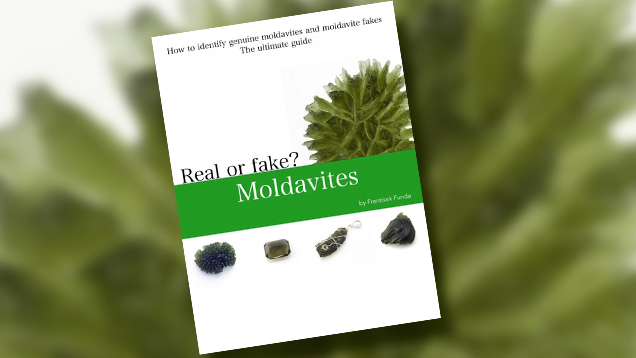Book Review: Real or Fake? Moldavites

Moldavite is an impact glass, produced when terrestrial silica is fused in the intense heat and pressure created by the crash of large meteorites. The identification of faceted moldavite is quite simple. Besides their flow structure and abundant bubbles, moldavites contain “wires” or “corkscrews” of lechatelierite, a high-temperature form of SiO2 that is very easy to see due to its low refractive index. Since identification of unfaceted material can be a real challenge, I was looking forward to finding out whether the book would provide additional data on this subject.
In Real or Fake? Moldavites, author František Funda discusses numerous topics pertaining to the material in a reader-friendly format. The book covers the materials’s gemological properties and cut and raw moldavites. It then branches out into material from the Besednice deposit in the Czech Republic (famous for its beautiful raw moldavites), handmade glyptic sculptures in natural moldavite, tumbled and broken moldavite, and moldavite in jewelry. It has appendices with an extensive list of worldwide available gemological laboratories and chemical composition of moldavites based upon analytical results from other authors.
The original Czech text has been translated by a non-native English speaker. This explains the use of the German word schlieren to describe the swirls in the inner structure section.
The chapter on raw material is informative, as the identification of moldavite with a natural-looking surface is rather difficult. The surface feature of natural moldavite is caused by natural etching, and the author invites us to look for evidence of this process such as sharp protrusions. Other features of natural moldavite include lechatelierite needles and atypical shapes on the surface such as channels, open-ended bubbles, and residues of clay or ferruginous sandstone from the sediment matter in which the moldavites are found. What especially distinguishes a Besednice moldavite from all of the others are the sharp spikes, which have given these moldavites the very unglamorous nickname of “hedgehog.”
A full chapter is devoted to moldavite’s gemological properties and how they may be used to identify natural specimens. Funda writes that the material’s RI and relative density overlap with artificial glass. While natural moldavites are inert to long-wave and short-wave UV, some imitations have a chalky fluorescence in short-wave UV.
The text is illustrated with color images throughout, but unfortunately the photos lack any kind of indication on the size of the specimens. The book is being advertised as the ultimate guide for both laymen and professional gemologists that will teach you how to recognize an authentic moldavite from an imitation. This is obviously untrue, as readers are invited to read more about the inhomogeneity and the inner structure of moldavites in a forthcoming book called Facts about Moldavites. The author is passionate about the subject, but the title of the book sets a high expectation which it did not meet.



